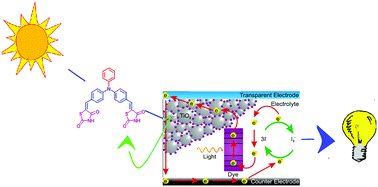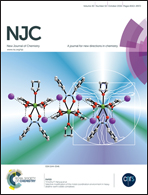Novel D–π–A type triphenylamine based chromogens for DSSC: design, synthesis and performance studies†
Abstract
In this work, four novel D–π–A organic dyes (MH, MT, DT, DH) consisting of triphenylamine as an electron donor and 2,4-thiazolidinedione/hydantoin as anchoring groups were designed and synthesized for use in dye-sensitized solar cells (DSSCs). The synthesized dyes were characterized using FT-IR, NMR, mass spectrometry, absorbance and electrochemical measurements. The photophysical, electrochemical and photovoltaic properties of the solar cells based on these dyes were investigated to study the effect of two different anchoring groups on the performance of the dye-sensitized solar cells. The dye consisting of two hydantoin anchoring groups shows the highest conversion efficiency of 2.70% (short-circuit current = 7.60 mA cm−2, open circuit voltage = 570 mV, and fill factor = 0.62 under standard AM1.5G irradiation) compared to the other designed dyes. The observed results will provide basic information for the future design of sensitizers with different anchoring groups for photovoltaic applications.


 Please wait while we load your content...
Please wait while we load your content...